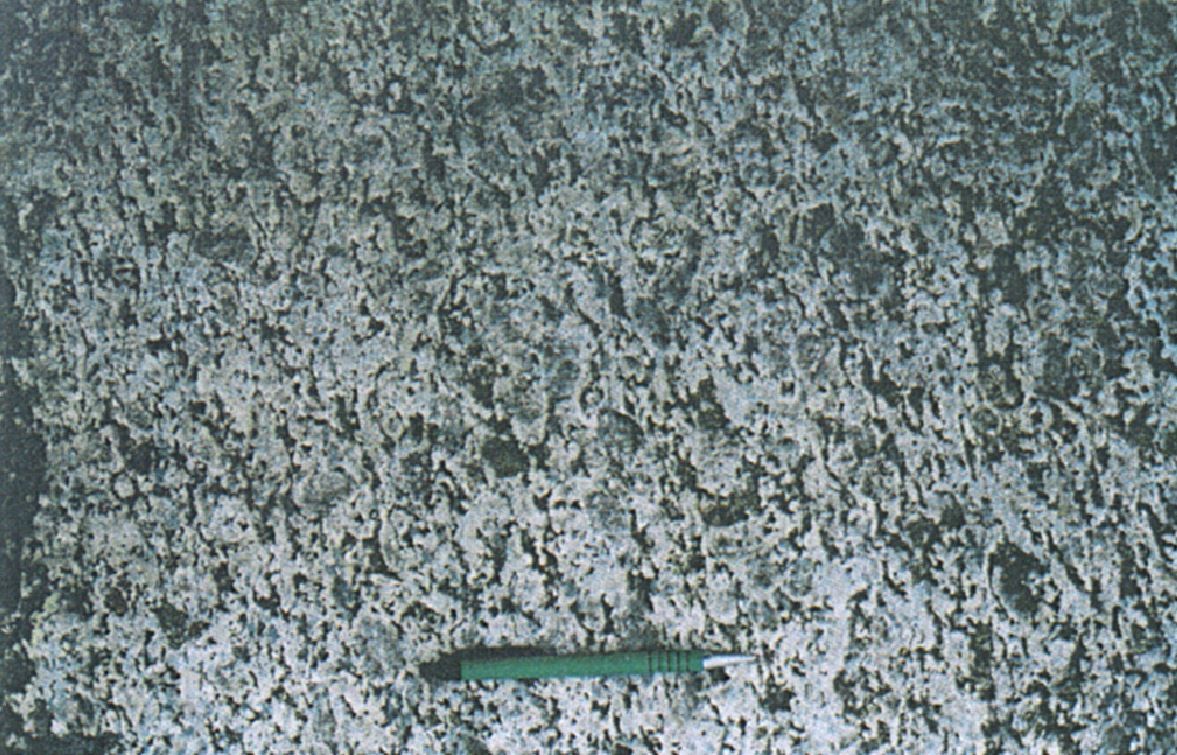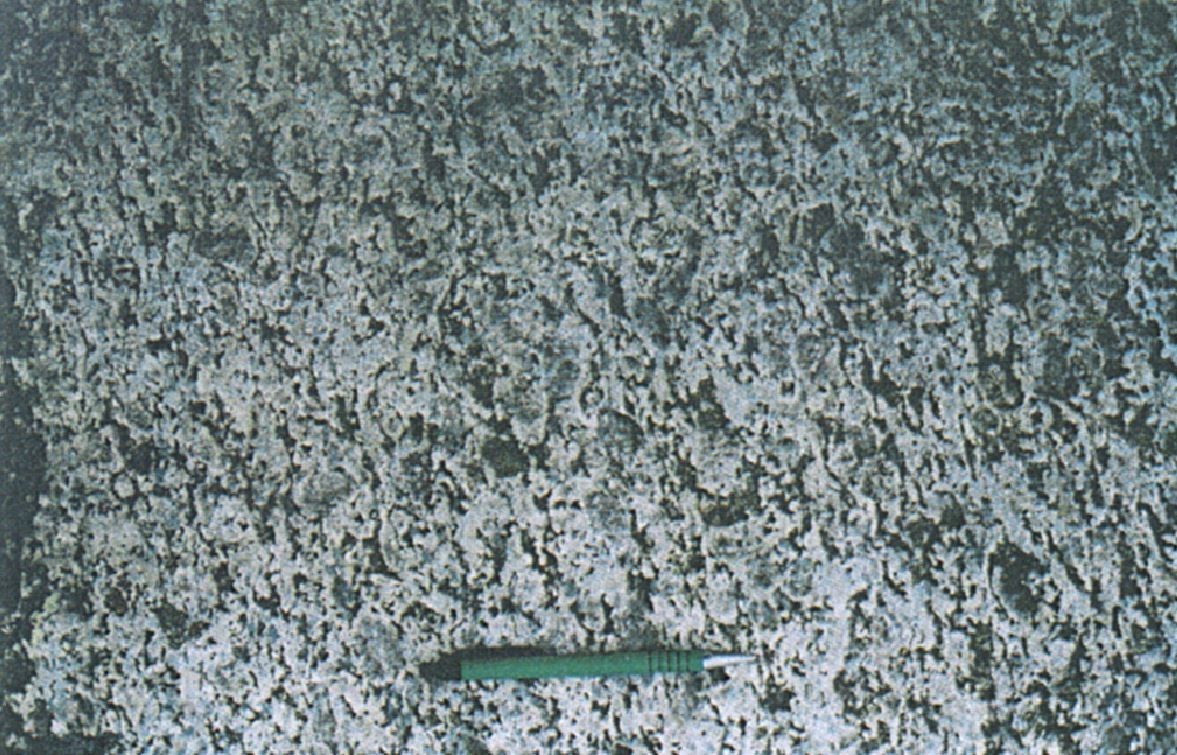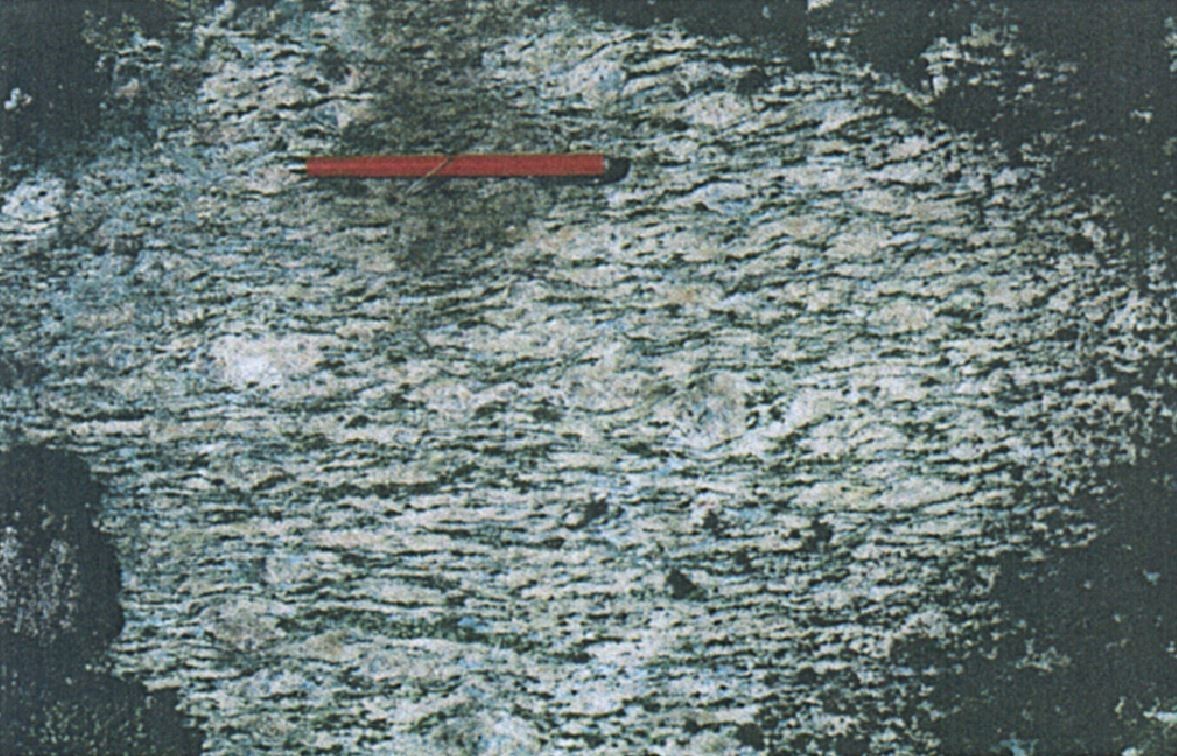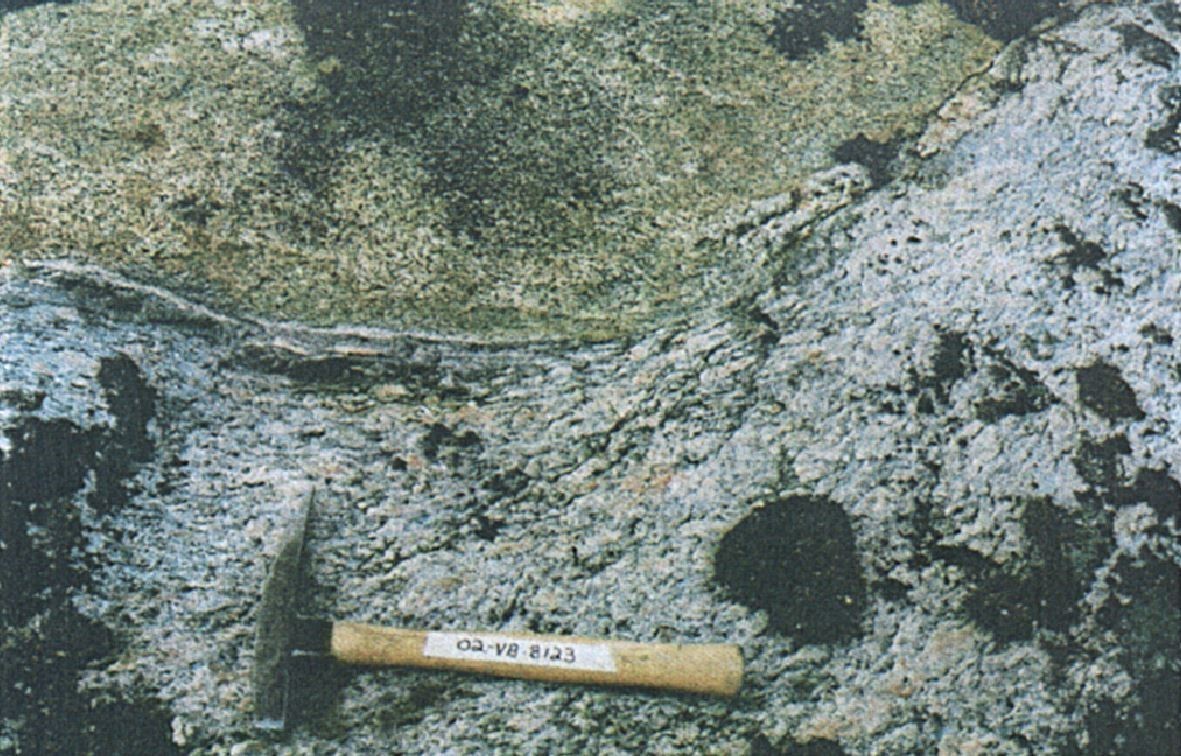
DISCLAIMER: This English version is translated from the original French. In case of any discrepancy, the French version shall prevail.
| Author(s): | Maurice et al., 2004 |
| Age: | Neoarchean |
| Stratotype: | None |
| Type area: | Povungnituk area (NTS sheet 35C) |
| Geological province: | Superior Province |
| Geological subdivision: | Minto Subprovince |
| Lithology: | Felsic to intermediate intrusive rocks |
| Category: | Lithodemic |
| Rank: | Suite |
| Status: | Formal |
| Use: | Active |
None
Background
The Pinguq Suite was introduced to group large masses of porphyroclastic granitoid, and intrusions of granite, granodiorite, syenite and diorite observed in the western part of the Puvirnituq area (Maurice et al., 2004, 2005a; sheet 35C). It was extended further south in the Kogaluk Bay area (sheet 34N; Maurice et al., 2005b). Subsequently, Simard et al. (2008) assigned to the suite granite and granodiorite intrusions formerly part of the La Chevrotière Suite in the Kogaluk Bay, Puvirnituq and Vigneau Lake (sheet 35F02) areas. The name refers to the Pinguq Hill located NW of the unit.
Description
The Pinguq Suite consists mainly of monzogranite, granodiorite and quartz monzonite characterized by a porphyraceous texture and the presence of blue quartz grains (nApin1; Maurice et al., 2004, 2005a, 2005b; Simard et al., 2008; Simard, 2008). These granitoid masses are associated with N-S oriented shear zones and preferentially located in places marked by high to very high magnetic signatures (Maurice et al., 2004, 2005). They contain biotite and are foliated to mylonitic. Small homogeneous granite and granodiorite intrusions (nApin2 and nApin3, respectively), even-grained and massive to foliated, are also associated with porphyraceous rocks. The suite also includes quartz syenite (nApin4) and biotite diorite (nApin5) in smaller amounts. The following descriptions of informal units are taken from Maurice et al. (2004, 2005a, 2005b), MNRF (2007, 2010a-b) and Lamothe and Simard (2010, 2011).
Pinguq Suite 1 (nApin1): Blue Quartz Porphyroclastic Monzogranite, Granodiorite and Quartz Monzonite
Unit nApin1 is distinguished from porphyritic granitoids of the La Chevrotière Suite by its large volume (<10 km by 80 km), the ubiquity of microcline porphyroclasts locally forming an augen protomylonitic texture, and the common presence of blue quartz. The composition of the rock varies from granodiorite to quartz monzonite, with a predominance of monzogranite. These rocks are pink grey to reddish, foliated to protomylonitic, and commonly display quartz bands, rounded porphyroclasts (eyes) and microcline megaporphyroclasts up to 7 cm long. The intensity of deformation and associated alteration (epiotization and chloritization) is not homogeneous. Elongated decimetric enclaves of diorite and amphibolite (<5%) make up a small proportion of outcrops.
In thin sections, green to brown biotite is the most abundant ferromagnesian mineral, while green hornblende, and more locally clinopyroxene, appears in intermediate rocks. Myrmekite grains partially cut and outline microcline porphyroclasts, which contain biotite and sericitized plagioclase inclusions. Deformation was largely absorbed by quartzofeldspathic clusters crushed or recrystallized around microcline porphyroclasts. Accessory minerals are apatite, titanite, zircon and opaque minerals. Secondary minerals commonly include sericite and epidote (replacing plagioclase crystals), as well as chlorite and carbonate clusters (also replacing plagioclase).
Pinguq Suite 2 and 3 (nApin2 and nApin3): Homogeneous Granite and Granodiorite
Small granite (nApin2) and granodiorite (nApin3) intrusions of the Pinguq Suite are associated with N-S oriented mylonitic shear zones. Granite and granodiorite are white to pinkish, homogeneous, even grained, massive to foliated, locally mylonitic, and medium to coarse grained. Enclaves of intermediate to ultramafic rocks (diorite, amphibolite and ultramafic rocks) can account for up to 20% of outcrops. They are stretched parallel to foliation or are reduced to thin ferromagnesian mineral schlierens. In thin sections, relic igneous textures are locally observed. Quartz, locally bluish, usually forms monocrystalline lenses and bands parallel to foliation. Brown to green biotite is the main ferromagnesian phase and may be associated with hornblende, in addition to clinopyroxene locally. Allanite forms millimetric crystals and magnetite is common.
Pinguq Suite 4 (nApin4): Quartz Syenite
Unit nApin4 consists of a single kilometric strip of leucocratic, fine to medium-grained and moderately magnetic quartz syenite. Its modal composition consists of 5-20% plagioclase, 5-15% quartz, >60% K-feldspar and <5% biotite. The rock is characterized by a strong mineral lineation defined by quartz stretching and the alignment of biotite grains characterizing an « L-tectonite ».
Pinguq Suite 5 (nApin5): Diorite
Unit nApin 5 groups small masses, dykes or enclaves of fine or medium-grained granular biotite diorite. Diorite contains relics of plagioclase of primary origin. Green or brown biotite is the main ferromagnesian mineral; it is locally replaced by a light green amphibole and contains fine rutile needles forming mesh textures in coarser crystals. The rock also contains magnetite (~5%) and titanite (2-5%). Thus, the unit is distinguished by high magnetic susceptibility and high titanium contents (~2% TiO2).
Thickness and distribution
The Pinguq Suite occupies a large area of the NW end of the Minto Subprovince in the Povungnituk area (sheets 34N, 35C and southern end of sheet 35F) and follows a general N-S orientation. The monzogranite, granodiorite and quartz monzonite unit (nApin1) is the most important in the Pinguq Suite. Homogeneous granite and granodiorite units (nApin2 and nApin3) are smaller, but spread over the entire area of the suite. Units nApin4 and nApin5 are much smaller, with quartz syenite forming a strip <2 km wide by 15 km long in the centre of the Pinguq Suite (boundary of sheets 34N15 and 35C02), while biotite diorite occurs as isolated masses (5-10 km long by 1-2.5 km wide), enclaves in unit nApin1, and dykes cutting supracrustal and enderbitic rocks of the Qilalugalik Suite (abandoned unit; Maurice et al., 2004, 2005a).
Dating
A U-Pb crystallization age on zircon of 2724 ±2 Ma was obtained in a porphyritic monzonite in the far west of the unit (David, 2012). A porphyitic monzogranite with a protomylonitic texture, located near a deformation zone, yielded two U-Pb ages on zircon, a crystallization age of 2727 ±2 Ma and an inherited age of 2752 ±3 Ma (David, 2012).
| Unit | Sample Number | Isotopic System | Mineral | Crystallization Age (Ma) | (+) | (-) | Inherited Age (Ma) | (+) | (-) | Reference(s) |
| nApin1 | 02-MS-5020A | U-Pb | Zircon | 2724 | 2 | 2 | David, 2012 | |||
| 02-OR-6106A | U-Pb | Zircon | 2727 | 2 | 2 | 2752 | 3 | 3 |
Stratigraphic Relationship(s)
Llithological characteristics of the Pinguq Suite are comparable to those of La Chevrotière and Leridon suites. However, intrusions of the Pinguq Suite are distinguished from those of the other two by increased deformation, the ubiquity of microcline porphyroclasts having an augen protomylonitic texture, and the common presence of blue quartz (Maurice et al., 2004, 2005a, 2005b). According to Maurice et al. (2005b), Pinguq Suite intrusions underwent ductile deformation synchronous to their implacement. Simard et al. (2008) consider the Pinguq, La Chevrotière and Leridon suites to be equivalent and associated with a significant potassic magmatic event in northern Minto Subprovince, between 2735 Ma and 2720 Ma
Paleontology
Does not apply.
References
Publications Available Through SIGÉOM Examine
DAVID, J. 2012. Datations isotopiques effectuées dans le nord-est de la Province du Supérieur (Travaux de 2001, 2002 et 2003). MRNF. DV 2012-05, 84 pages.
LAMOTHE, D., SIMARD, M. 2010. COMPILATION GEOLOGIQUE DE L’OROGENE DE L’UNGAVA (VERSION PRELIMINAIRE). MRNF. RP 2010-05, 1 page and 1 plan.
LAMOTHE, D., SIMARD, M. 2011. GEOLOGICAL COMPILATION OF THE UNGAVA OROGEN (PRELIMINARY VERSION). MRNF. RP 2010-05(A), 1 page.
MAURICE, C., BERCLAZ, A., DAVID, J., SHARMA, K N M., LACOSTE, P. 2004. GEOLOGIE DE LA REGION DE POVUNGNITUK (35C) ET DE KOVIK BAY (35F). MRNFP. RG 2003-06, 44 pages and 2 plans.
MAURICE, C., BERCLAZ, A., DAVID, J., SHARMA, K N M., LACOSTE, P. 2005a. GEOLOGY OF THE POVUNGNITUK (35C) AND KOVIC BAY (35F) AREAS. MRNF. RG 2004-05, 41 pages and 2 plans.
MAURICE, C., LACOSTE, P., BERCLAZ, A., DAVID, J., SHARMA, K N M. 2005b. GEOLOGIE DE LA REGION DE KOGALUK BAY (34N ET 34M). MRNFP. RG 2004-01, 37 pages and 2 plans.
MRNF 2007. COMPILATION GÉOSCIENTIFIQUE – GÉOLOGIE 1/50 000, 35F02 – LAC VIGNEAU. In MRNF. 2010. CARTE(S) GÉOLOGIQUE(S) DU SIGEOM – feuillet 35F. CG SIGEOM35F, 16 plans.
MRNF. 2010a. CARTE(S) GÉOLOGIQUE(S) DU SIGEOM – feuillet 34N. CG SIGEOM34N, 1 plan.
MRNF. 2010b. CARTE(S) GÉOLOGIQUE(S) DU SIGEOM – feuillet 35C. CG SIGEOM35C, 1 plan.
SIMARD, M. 2008. LEXIQUE STRATIGRAPHIQUE DES UNITÉS ARCHÉENNES DU NORD-EST DE LA PROVINCE DU SUPÉRIEUR. MRNF. DV 2008-03, 107 pages.
SIMARD, M., LABBE, J Y., MAURICE, C., LACOSTE, P., LECLAIR, A., BOILY, M. 2008. SYNTHÈSE DU NORD-EST DE LA PROVINCE DU SUPÉRIEUR. MRNF. MM 2008-02, 198 pages and 8 plans.
Suggested Citation
Ministère de l’Énergie et des Ressources naturelles (MERN). Pinguq Suite. Quebec Stratigraphic Lexicon. https://gq.mines.gouv.qc.ca/lexique-stratigraphique/province-du-superieur/suite-de-pinguq_en [accessed on Day Month Year].
Contributors
|
First Publication |
Céline Dupuis, P. Geo., Ph.D. celine.dupuis@mern.gouv.qc.ca (redaction, French and English versions) Mehdi A. Guemache, P. Geo., Ph.D. (coordination); anonymous (critical review); Simon Auclair, P. Geo., M.Sc. (editing); Nathalie Bouchard (HTML editing). |




